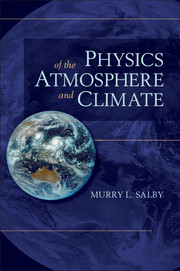Book contents
- Frontmatter
- Contents
- Preface
- Prelude
- 1 The Earth-atmosphere system
- 2 Thermodynamics of gases
- 3 The Second Law and its implications
- 4 Heterogeneous systems
- 5 Transformations of moist air
- 6 Hydrostatic equilibrium
- 7 Static stability
- 8 Radiative transfer
- 9 Aerosol and cloud
- 10 Atmospheric motion
- 11 Atmospheric equations of motion
- 12 Large-scale motion
- 13 The planetary boundary layer
- 14 Wave propagation
- 15 The general circulation
- 16 Dynamic stability
- 17 Influence of the ocean
- 18 Interaction with the stratosphere
- Appendix A Conversion to SI units
- Appendix B Thermodynamic properties of air and water
- Appendix C Physical constants
- Appendix D Vector identities
- Appendix E Curvilinear coordinates
- Appendix F Pseudo-adiabatic chart
- Appendix G Acronyms
- Answers to selected problems
- References
- Index
- Plate section
16 - Dynamic stability
Published online by Cambridge University Press: 05 June 2012
- Frontmatter
- Contents
- Preface
- Prelude
- 1 The Earth-atmosphere system
- 2 Thermodynamics of gases
- 3 The Second Law and its implications
- 4 Heterogeneous systems
- 5 Transformations of moist air
- 6 Hydrostatic equilibrium
- 7 Static stability
- 8 Radiative transfer
- 9 Aerosol and cloud
- 10 Atmospheric motion
- 11 Atmospheric equations of motion
- 12 Large-scale motion
- 13 The planetary boundary layer
- 14 Wave propagation
- 15 The general circulation
- 16 Dynamic stability
- 17 Influence of the ocean
- 18 Interaction with the stratosphere
- Appendix A Conversion to SI units
- Appendix B Thermodynamic properties of air and water
- Appendix C Physical constants
- Appendix D Vector identities
- Appendix E Curvilinear coordinates
- Appendix F Pseudo-adiabatic chart
- Appendix G Acronyms
- Answers to selected problems
- References
- Index
- Plate section
Summary
Disturbances in the rotating cylindrical annulus are a laboratory analogue of synoptic weather systems, which prevail outside the tropics. Each develops through instability of the zonal-mean circulation. Instability was considered earlier in relation to the vertical stratification of mass (Chap. 7). If distributions of temperature and humidity violate the conditions for static stability, then small displacements lead to parcels accelerating away from their undisturbed positions. Unlike the response under stable stratification, this reaction leads to finite displacements of air. Fully developed convection then rearranges air, driving the stratification toward neutral stability.
Two classes of instability are possible. Parcel instability follows from reinforcement of air displacements by a negative restoring force, as occurs in the development of convection. Wave instability occurs in the presence of a positive restoring force, but one that amplifies parcel oscillations inside wave motions. Unstable waves amplify by extracting energy from the mean circulation, for example, from available potential energy that accompanies baroclinic stratification and vertical shear (Chap. 15). Strong zonal wind that follows from the nonuniform distribution of atmospheric heating, in concert with geostrophic balance, makes this class of instability the one most relevant to the large-scale circulation. Like parcel instability, it develops to neutralize instability in the mean flow. This objective is achieved through the rearrangement of air.
- Type
- Chapter
- Information
- Physics of the Atmosphere and Climate , pp. 515 - 532Publisher: Cambridge University PressPrint publication year: 2012

